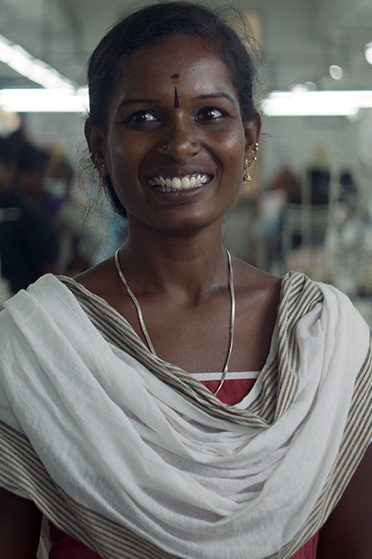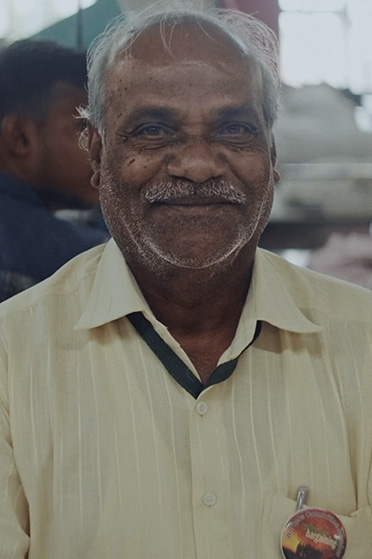Introducing the Global Responsible Textile Standard (GRTS)
Global Standard, the independent, self-funded non-profit behind the Global Organic Textile Standard (GOTS), exists to drive the highest level of social and environmental impact in textile value chains through voluntary sustainability standards and related activities. Guided by the principles of health, ecology, fairness, and care, Global Standard believes in a world where all textiles are produced to enhance people’s lives and the environment.
To further this mission beyond organic textiles, Global Standard is launching the Global Responsible Textile Standard (GRTS). GRTS is a new voluntary sustainability standard that applies the same stringent social and environmental criteria - and the same proven third-party certification process -as GOTS. While GOTS focuses on organic fibres, GRTS expands this credibility and assurance to a defined set of other responsible fibres.
If you're already GOTS-certified, adopting GRTS is simple and efficient. Many GOTS-certified entities already process fibres that fall outside the scope of GOTS. GRTS allows them to extend rigorous certification to these materials as well, enabling a greater portion of their output to be covered by a voluntary sustainability standard (VSS) without adding complex new processes.
Why GRTS?
First established in 2006, the Global Organic Textile Standard (GOTS) has been internationally recognised by governments, industry, NGOs and consumers. Today, it is the world’s leading processing standards for organic textiles, applied across more than 15,000 certified facilities in 87 countries - and continuously growing.
Building on this proven foundation, the Global Responsible Textile Standard (GRTS) represents a natural evolution. It extends the same rigorous criteria, independence, and trusted third-party assurance to a defined set of responsible non-organic fibres - helping to scale across a broader material base, which simply means more common impact on sustainable development.
GRTS offers companies a practical and credible solution to meet growing expectations around value chain transparency and responsible sourcing. It supports businesses in navigating tightening regulatory landscapes while demonstrating their commitment to social and environmental integrity beyond organic materials.
Principles and Criteria of GRTS
GRTS will share the foundational principles that define GOTS, including:
- Human rights and social criteria, including prohibition of child and forced labour, non-discrimination, and safe working conditions.
- Ecological Criteria, requiring environmentally friendly processes and materials including process chemicals
- Responsible Business Conduct
- Due Diligence: Implementing rigorous assessment processes to verify the environmental and ethical practices of a company.
- All Processing Stages: Encompassing every step of production to ensure holistic sustainability.
- Traceability: Ensuring the transparent tracking of materials and volume reconciliation hroughout the value chain.
- Third Party Certification: Validating compliance through independent certification bodies.
- No GMO origin fibres
- Comprehensive coverage along the entire value chain, from raw material to final product.
Scope and Eligibility
- GRTS will apply to a defined list of responsible fibres, as registered in the Global Fibre Registry.
- Companies that hold a valid GOTS Scope Certificate are eligible for GRTS.
- No separate certification procedure for GOTS Certified companies. GRTS can be an add-on to GOTS.
- GRTS certification may be applied for as a stand-alone by companies who are not GOTS certification.
Development Timeline
The development of GRTS follows the transparent, multi-stakeholder approach aligned with ISEAL best practices:
- Launch of 1st public consultation period: 14th July 2025, open until 14th September 2025
Participate in the Public Consultation
Global Standard invites all interested stakeholders - companies, NGOs, citizens and auditors - to participate in the public consultation process. The public consultation is open until 14th September 2025. Your input ensures the standard is practical, relevant, and aligned with industry needs.
The draft version of GRTS is available here.
The draft version of the Implementation Manual for GRTS is here.
Submit your comments through this form: https://forms.office.com/e/afBPYKYw5R
STAY INFORMED
To receive updates about GRTS milestones, consultation events and final publication use the form below.
Frequently asked questions
-
What is GRTS?
The Global Responsible Textile Standard (GRTS) is a voluntary sustainability standard developed by Global Standard, the non-profit organisation behind the renowned Global Organic Textile Standard (GOTS). GRTS applies the same rigorous environmental and social criteria, traceability systems, and third-party certification infrastructure as GOTS but to a broader range of fibres that are certified and meet the standard’s definition of responsibility (see below). In a nutshell: GRTS is GOTS with alternative fibres to organic.
-
Why was GRTS developed? Why another standard?
GRTS was developed by non-profit Global Standard to address a clear and growing need within the textile industry for a credible sustainability standard that goes beyond organic fibres. While GOTS remains the gold standard for organic textiles, many GOTS-certified companies also process other responsible materials for which no common certification framework exists. By introducing GRTS, Global Standard enables companies to certify products made from responsibly sourced fibres using the same rigorous social and environmental criteria, third-party verification, and traceability infrastructure as GOTS. This ensures that responsible production practices can be applied consistently across a broader range of fibre types, without diluting the meaning or credibility of either standard.
-
What does "responsible" mean in the context of GRTS?
“Responsible” in GRTS refers specifically to the fibres used. GRTS does not define new fibre standards. Instead, it accepts fibres certified under existing third-party standards that meet strict criteria, among them:
1. Chain-of-custody traceability with physical segregation (not mass balance);,
2. Third-party certification,
3. Non-GMO,
4. Exclusion of highly hazardous pesticides, and
5. No mulesing for wool.
Only fibres that meet all these conditions are considered eligible. -
Is GRTS intended to replace or complement GOTS?
No. GRTS does not replace GOTS. It complements it. GOTS remains the gold standard for organic textiles and will continue to be maintained and developed. GRTS serves a different purpose: it certifies products made with certified responsible fibres, using the same systems, procedures, and principles that underpin GOTS.
-
Will there be a long-term merger of the two standards?
No. GOTS and GRTS are designed as two distinct but complementary standards. While they share the same certification infrastructure and many core criteria, they serve different purposes.
-
Will it be beneficial to already hold GOTS certification when applying for GRTS?
Yes, it will be beneficial. Holding a valid GOTS Scope Certificate will allow these companies to directly receive a GRTS scope certificate upon application to their Certification Bodies and a review by those Certification Bodies.
GRTS uses the same Certification Bodies, traceability tools, environmental and social criteria, and audit processes as GOTS. GOTS-certified companies are already familiar with these systems and can extend their scope with minimal effort.
-
Will Global Standard continue to maintain and develop GOTS in parallel?
Yes. Global Standard will continue to maintain, develop, and promote GOTS independently of GRTS. GOTS remains a foundational standard and will not be deprioritised or merged. GRTS is an additional certification pathway, not a replacement, and both standards will operate in parallel with distinct labelling rules (the document will be called CUS-GRTS. And the existing CUGS shall be renamed CUS-GOTS.)
-
Will GRTS cover the entire value chain from fibre to final product?
Yes. GRTS will cover every stage of the textile value chain, from the certified responsible fibre to the final labelled product. Each stage is subject to independent third-party verification and volume reconciliation, ensuring full traceability and compliance throughout the value chain. In doing so, GRTS provides a comprehensive, end-to-end assurance of environmental and social responsibility.
-
How does Global Standard ensure that GRTS does not diminish the value of GOTS?
Global Standard will maintain GOTS as the gold standard for organic textiles. GRTS has been intentionally developed to complement, not replace, GOTS. Several safeguards are in place to protect the value and credibility of both GOTS and GRTS:
Separate labelling: Products cannot carry both GOTS and GRTS labelling. This prevents dilution of the GOTS message and ensures a clear distinction between the two certifications.
- Companies will be inspected and audited to all of GOTS requirements in order to receive GRTS scope certificates, ensuring that GOTS remains the foundation of the new standard.
- No overlap in fibre scope: GRTS explicitly excludes products with more than 69% organic content, which remain within the scope of GOTS.
- Shared high standards: Both GOTS and GRTS are held to the same rigorous environmental, social, and traceability requirements, ensuring that the credibility of GOTS is not compromised.
This structure allows companies to expand their sustainability practices without weakening the unique position and strength of GOTS.
-
What product categories are planned to be included (e.g., apparel, home textiles, footwear)?
GRTS will cover the same product categories as GOTS. These include, but are not limited to, fashion, apparel, home textiles, accessories, and personal care products. The goal is to provide a seamless certification option for companies already working with these product types under GOTS, while extending the scope to other certified responsible fibres. At the same time, GRTS ensures that products are clearly differentiated through appropriate labelling, supporting transparency and informed choice throughout the market.
-
What criteria are shared between GOTS and the current GRTS draft?
The current draft of GRTS has been intentionally designed to align closely with the established principles and criteria of GOTS, ensuring a seamless extension for companies already operating within the GOTS framework. All key GOTS requirements - from human rights and social responsibility to environmental protection, chemical management, and due diligence - are fully reflected in GRTS.
In detail, GRTS and GOTS share the following core criteria:- Traceability: Full value chain transparency from fibre to finished product.
- Due diligence criteria: Clear responsibilities for companies to identify, assess, and address risks to people and the environment in their value chains, aligned with international frameworks on human rights and environmental due diligence.
- Environmental criteria: Use of approved chemicals, wastewater treatment, emissions controls, and other ecological safeguards, all contributing to both environmental protection and consumer product safety.
- Social criteria: Mandatory respect for human rights, safe working conditions, no child or forced labour, and freedom of association.
- Third-party certification: Compliance is verified through accredited, independent Certification Bodies.
- Full value chain coverage: All processing stages are certified, no exceptions.
- Multi-stakeholder governance: Both standards are governed through transparent, inclusive processes in line with ISEAL best practices.
This alignment ensures that companies certified to GOTS can efficiently extend their practices and certifications to GRTS without duplicating systems or audits.
Fibre Eligibility
-
What fibres are proposed to be eligible under GRTS?
The fibres that will be eligible for use in GRTS Goods include natural plant and animal fibres, regenerated cellulosic fibres, biopolymers, select synthetics, and recycled fibres. All fibres used in GRTS-certified products must be certified and registered in the Global Fibre Registry. Please see the answer to question 3 for more details.
-
Which fibre production standards are proposed for acceptance under GRTS?
GRTS will only accept fibre production standards that meet a defined set of minimum criteria for responsible production. In the current draft of GRTS, these include:
o Chain-of-custody traceability with physical segregation (mass balance is not allowed)
o Independent third-party certification
o Prohibition of genetically modified organisms (GMO)
o Ban on highly hazardous pesticides
o Mandatory assurance of animal welfare, including a ban on mulesing in wool production
A. Fibre Standards and Feedstock that have been found to comply with the responsible criteria as defined by GRTS
A1 : With additional supporting evidence as necessary (e.g. GMO test, mulesing-free)
MULTI-FIBRE STANDARDS (with proof of non-GMO and possibly non-mulesing)
1. Fairtrade Textile Standard
2. Organic – IFOAM Family of Standards (also organic in-conversion)
a. Organic Australia (requires non-mulesing verification)
3. Organic – non-IFOAM (also organic in-conversion)
4. Organic Content Standard (also organic in-conversion)
5. Regenerative Organic (USDA Organic + ROC)
COTTON FIBRE STANDARDS (with non-GMO proof)
6. Better Cotton
7. Cotton Connect REEL
8. Cotton Made in Africa
9. myBMP Australia
10. Regenerative Cotton Standard
11. Responsible Brazilian Cotton
BAST FIBRE STANDARDS
12. Masters of Flax (European Flax) Standard
13. Responsible Hemp Standard
ANIMAL FIBRE STANDARDS
14. Responsible Wool Standard
15. Good Cashmere Standard
16. Sustainable Animal Fibre Standard
17. Responsible Alpaca Standard
18. Responsible Mohair Standard19. ZQ Natural Fibre
20. New Zealand Wool
MANMADE CELLULOSIC / SYNTHETIC / RECYCLED FIBRE STANDARDS
21. Forest Stewardship Council (FSC)
22. Programme for the Enforcement of Forest Certification (PEFC)
23. International Sustainable and Carbon Certification
24. Global Recycled Standard
25. Recycled Claim Standard
26. Recycled Content Standard
A2 : To Be Determined (due to insufficient information being available)
1. Materials Matter Standard
2. Rainforest Alliance
3. Regenevate
4. Regenified
5. REEL Regenerative
B. FIBRE STANDARDS EXCLUDED BY CRITERIA
1. Climate Beneficial
2. Global Gap
3. RegenAgri
4. Sustainable Cape Wool Standard
5. Sustainable Regenerated Cellulosics Content Standard
6. US Cotton Trust Protocol
-
What draft criteria determine fibre eligibility (e.g., carbon footprint, biodegradability, recyclability, social impact)?
The primary criteria for qualification as “responsible” fibre production standards include:
o Chain-of-custody traceability with physical segregation (mass balance is not allowed)
o Independent third-party certification
o Prohibition of genetically modified organisms (GMO)
o Ban on highly hazardous pesticides
o Mandatory assurance of animal welfare, including a ban on mulesing in wool production
These criteria are designed to ensure that all fibres used in GRTS-certified products are produced in a way that is ecologically sound, socially responsible, and transparently verified.
-
Will fibres like conventional cotton, regenerative cotton, or "organic in-conversion" fibres be considered?
Conventional fibres that do not meet the GRTS minimum criteria for responsible production will not be accepted. Regenerative cotton will be accepted only if certified to a defined “responsible” standard. Organic and organic in-conversion fibres may be used in GRTS products, but must make up less than 70% of the total fibre content. Products with 70% or more organic content fall within the scope of GOTS, not GRTS.
-
Will blended fibres (e.g., organic cotton + recycled polyester) be eligible?
Yes. Fibre blends are eligible for GRTS certification, provided that the fibre content satisfies GRTS requirements. Primary fibres used need to be certified as responsible. Synthetic fibres will be subject to specific limitations, particularly related to production processes and environmental impact.
GRTS permits a maximum of 10% of only specific synthetic fibres (as additional materials) when necessary for functionality.
-
Are there proposed minimum fibre content requirements?
Yes. GRTS sets certain key thresholds:
- At least 90% of fibres in any GRTS-certified product must be recognised as “responsible” under the standard.
- GRTS permits a maximum of 10% additional fibres as specified in the Standard.
- Products containing less than 70% organic or organic in-conversion fibres are permitted to remain within the scope of GRTS
This ensures a clear distinction between GRTS and GOTS while maintaining the integrity of both standards.
-
How can fibre producers or innovators submit new fibres for inclusion?
As part of public consultation procedures, Global Standard will publish the assessment criteria for “responsible” fibre standards.
Standard setters will be invited to complete a self-assessment demonstrating alignment with these criteria. These submissions shall be evaluated by Global Standard. Fibre standards that pass the minimum criteria will be included in the initial list of accepted standards.
The process will remain open, allowing additional submissions over time.
The procedure for this is being developed and shall be available on the GRTS website before final release of the GRTS Standard.
-
Are synthetic (oil-based) fibres permitted, and if so, under what conditions?
Apart from the specifically defined additional fibres (maximum 10%), recycled synthetic fibres may be accepted under GRTS, provided they are certified and produced in closed-loop manufacturing processes. Details of this requirement have been placed in the GRTS Standard and Implementation Manual.
-
What is GRTS’s proposed position on GMO cotton?
GRTS maintains a strict non-GMO policy in alignment with the principles of organic agriculture. The use of genetically modified cotton or indeed regenerated cellulosics from GMO feedstock is not permitted under GRTS. This position is based on over 50 years of evidence which shows that the use of GMO is neither responsible nor sustainable. GRTS is designed to assist the transition from conventional chemical agriculture towards ecologically and socially responsible production, and the use of GMOs is included in this.
-
Given the global prevalence of GMO cotton, how does GRTS plan to support scalability while maintaining its principles?
GRTS will uphold its core principle of excluding GMO cotton, even in the face of widespread GMO cultivation. Rather than accepting GMO cotton, GRTS aims to increase demand for non-GMO cotton, thereby supporting farmers and seed producers who continue to cultivate it.
Non-GMO cotton is already widely available in several countries, and GRTS will reinforce this availability through market signals and certification uptake. Countries such as Turkey, Greece, Spain, Peru, and Kyrgyzstan have already banned GMO cotton cultivation, and GRTS will strengthen these efforts by creating clear market demand.
-
How does GRTS address animal-derived materials (e.g., wool, silk)?
Animal-derived fibres used in GRTS-certified products must come from sources that are certified to uphold strict animal welfare standards. Wool, for example, must be sourced from sheep that have not undergone mulesing or live lamb cutting. Only standards that can verify such practices will be accepted.
-
How will animal welfare be addressed, including practices like mulesing?
Animal welfare is a key criterion for responsible production. Where fibre standards do not explicitly address harmful practices such as mulesing, proof of compliance will be additionally required.
Environmental Criteria
-
Will the environmental processing requirements mirror GOTS, or will GRTS introduce new thresholds?
GRTS will mirror the environmental, chemical and processing requirements established under the GOTS framework. The ecological criteria of GOTS will apply without modification. If, in the future, new fibre types certified under GRTS require specialised processing that is not addressed by GOTS, additional requirements may be introduced. However, at this stage, no additional environmental thresholds are considered necessary for GRTS beyond those already defined by GOTS.
-
Will the Restricted Substances List (RSL) be identical to or differ from GOTS?
The Restricted Substances List (RSL) applied under GRTS will be identical to that of GOTS. Chemical residue and input assessments, as defined by GOTS, are to be followed without deviation.
-
What approach does GRTS take to reduce microplastic emissions?
GRTS will follow the approach set out in GOTS v8.0 regarding the prevention and management of microplastic pollution. This includes planned measures related to the assessment, control, and mitigation of microfibre release during textile processing and wastewater treatment. These measures, once finalised, will also be mandatory for GRTS. Please note that GOTS is currently being revised to version 8.0, including its provisions on microplastic pollution. Accordingly, GRTS’s related requirements are also in development and will be aligned with the final outcome of the GOTS v8.0 revision process. GRTS will ensure that, once adopted, these obligations are fully implemented and monitored across certified operations.
-
What kind of evidence or data is expected to demonstrate reduction in GHG emissions, water use, and contamination?
GRTS will require the same type of documentation and evidence as specified under GOTS v8.0 for all applicable environmental management criteria. This includes data on resource consumption (such as energy, water, and chemicals), as well as monitoring and reduction efforts; greenhouse gas (GHG) emissions management; and handling of wastewater, sludge, and textile waste. Before setting reduction targets, companies must first establish a baseline by documenting current levels of consumption and emissions. Based on this baseline, they are required to develop and implement appropriate reduction strategies targeting energy, water and chemical use; waste generation, and emissions released.
-
What indicators will be used to assess protection of soil health and biodiversity?
Protection of soil health and biodiversity will be addressed primarily at the level of raw fibre production and sourcing.
For example, agricultural practices used in growing natural fibres must adhere to responsible standards that promote ecological balance.
The use of hazardous chemicals in the processing of goods is already restricted under GRTS criteria. The standard also requires processors to ensure effluent discharge is treated appropriately. This effectively contributes to biodiversity, especially in an aquatic environment. For instance, substances classified as highly toxic to aquatic life (H400) or harmful to terrestrial species (H433) are prohibited.
These chemical management rules as well as waste management requirements (solid, liquid and air) contribute to the protection of ecosystems surrounding processing facilities.
-
What practical impact is GRTS expected to have on improving the sustainability of textile products?
GRTS will significantly enhance the sustainability of textile products by extending the proven framework of GOTS to a wider range of certified, responsible fibres. The application of strict environmental, social, and traceability requirements to a broader range of fibres, produced and processed within the credible and comprehensive GOTS sustainability framework, will play a key role in driving meaningful industry-wide improvements. This includes more transparent value chains, higher environmental integrity, and increased accountability in the production of textiles that fall outside the scope of organic certification
Human Rights and Social Criteria
-
What social and human rights criteria are included in the draft GRTS?
GRTS incorporates the full set of social and human rights criteria established in the GOTS framework. These include verified compliance with internationally recognised labour standards, such as those defined by the International Labour Organization. Certified Entities must demonstrate respect for workers’ rights, safe and hygienic working conditions, fair treatment, and access to grievance mechanisms. The criteria are designed to prevent abuse and promote dignity, equity, and accountability in the workplace.
-
Will GRTS require respect for human rights across the value chain?
Yes. GRTS will require respect for human rights throughout the entire certified value chain (including the manufacture of manmade fibres), just as GOTS does.
Every processing stage and certified entity must comply with the social criteria. This includes not only primary facilities but also subcontractors and service providers within the certified scope. Independent third-party audits will ensure that human rights obligations are met in practice, not just in policy.
-
How does GRTS address child labour, forced labour, and discrimination?
GRTS explicitly prohibits child labour, forced labour, and any form of discrimination. These prohibitions align directly with the GOTS social criteria and the core conventions of the International Labour Organization. Certified Entities must maintain clear policies and records that demonstrate compliance, and these are subject to independent audit and verification. Any breach of these principles constitutes grounds for suspension or withdrawal of certification.
-
Will GRTS require freedom of association and collective bargaining rights
Yes. Freedom of association and the right to collective bargaining are fundamental components of the GRTS social criteria, as inherited from GOTS. Certified facilities must allow workers to freely organise, join trade unions of their choice, and negotiate collectively.
-
How will compliance with social criteria be verified?
Compliance will be verified through on-site audits carried out by independent Certification Bodies. These audits will include worker interviews, documentation reviews, and physical inspections. Social criteria are integrated into the overall certification process and are assessed annually as part of routine inspections. Findings are documented in audit reports and must be addressed through corrective actions when necessary.
-
Will GRTS incorporate living wage benchmarks or wage transparency measures?
GRTS follows all social and human rights requirements of GOTS. The Standard(s) requires certified facilities to pay wages that meet or exceed legal minimums or industry benchmarks, whichever is higher.
The Standard(s) does not yet mandate payment of a full living wage, it encourages progress toward that goal and supports wage transparency. Certified facilities must keep accurate wage records and demonstrate fair and timely payment practices. Transparency in wage structures will be a standard audit requirement.
Any updates in the GOTS requirements will automatically apply to GRTS.
-
How does GRTS relate to frameworks like the UN Guiding Principles or OECD Due Diligence Guidance?
As GRTS builds upon the existing GOTS framework, it inherits a due diligence approach that is consistent with international expectations. GRTS therefore aligns closely with both the United Nations Guiding Principles on Business and Human Rights and the OECD Due Diligence Guidance for Responsible Value chains (see assessment results here).
The Due Diligence criteria include the integration of risk-based due diligence into certification requirements, ongoing monitoring and evaluation, stakeholder engagement mechanisms, and transparent procedures for managing grievances and remediation. This due diligence approach supports companies in identifying and managing social and environmental risks in line with international expectations.
-
Will GRTS help companies comply with upcoming social regulations like the EU CSDDD?
Yes. GRTS is designed to support compliance with emerging legislation such as the EU Corporate Sustainability Due Diligence Directive. By requiring Certified Entities to implement a structured due diligence process, maintain traceability, and verify social and environmental performance, GRTS provides the tools and documentation companies need to meet legal obligations for value chain responsibility. It helps bridge the gap between voluntary sustainability commitments and enforceable legal requirements.
Certification Eligibility & Process
-
What is the proposed process for obtaining GRTS certification?
There is no separate or additional certification process required for GRTS beyond what is already in place for the Global Organic Textile Standard (GOTS). GRTS has been developed as an extension of the GOTS framework. Any company that is already certified under GOTS can apply to have its certification scope extended to include GRTS through its existing GOTS-approved certification body.
-
Can GOTS-certified companies extend their certification scope to include GRTS?
Yes. All companies currently certified under GOTS may request to extend their scope to include GRTS. This extension can be initiated through the company’s existing certification body.
-
Is GOTS certification a prerequisite for GRTS?
No. GRTS certification may be obtained as a stand-alone, but companies that hold a valid GOTS Scope Certificate are automatically eligible to be certified under GRTS.
Certification to GRTS requires the implementation of most rules of GOTS which ensures that the same rigorous environmental, social, and traceability criteria required for GOTS are applied consistently at GRTS certified entities.
-
Can companies work with the same Certification Body (CB) for both GOTS and GRTS?
Yes, it will be a mandatory requirement should a company wish to obtain GRTS and GOTS certifications.
GRTS certification does not require a separate external approval process or certification infrastructure for Certification Bodies, either. All certification processes for GRTS and GOTS are integrated and overseen by the same accredited body.
-
Will existing GOTS-approved Certification Bodies (CBs) be automatically authorised for GRTS?
Yes, existing GOTS-approved Certification Bodies will be authorised to issue GRTS Scope Certificates. However, GOTS-Certified Entities must submit a formal application in order to obtain GRTS certification. Certification Bodies will assess the company's capability to meet GRTS requirements, and only upon successful verification will a separate GRTS Scope Certificate be issued. Since many GOTS-certified companies already produce a broader range of products, GRTS provides an efficient path to expand certification without duplicating audits.
-
Are there proposed differences in audit frequency or inspection requirements compared to GOTS?
There shall be no audit or inspection requirements for GRTS that are fundamentally disparate from GOTS, other than those directly linked to the fibres being processed.
The audit frequency shall remain the same for both Standards, and it is expected that companies who wish to obtain both certifications or add on one shall undergo assessments at the same time. This is cost-effective and efficient.
-
For an entity applying to get certified to GOTS and GRTS, could the audits be combined?
Yes. Since GRTS builds directly on the criteria and procedures already used in GOTS, all audits can and should be conducted simultaneously. This allows for a streamlined and efficient certification process, without duplicating efforts or increasing audit burdens for Certified Entities.
Labelling & Claims
-
What labelling options will be available for GRTS-certified products?
GRTS-certified products will be eligible for on-product and off-product labelling in accordance with a dedicated labelling policy. This policy, similar to the “Conditions for the Use of GOTS Signs,” will outline all labelling requirements, claims language, and graphical rules to ensure clarity, accuracy, and consistency across markets and communication channels.
-
Will GRTS have its own logo?
Yes. GRTS will have its own official logo that is distinct from the GOTS logo. This visual identity will support clear market differentiation between products certified under GRTS and those certified under GOTS, while maintaining consistent branding within the Global Standard family of standards. The logo will be available for use in accordance with the forthcoming GRTS labelling requirements document.
-
Will it be possible to combine GOTS and GRTS claims on a single product label or hangtag?
No. It will not be permitted to combine GOTS and GRTS claims on a single product label or hangtag. GOTS and GRTS are separate certification systems with distinct scopes.
-
Will retailers and e-commerce platforms require new guidance to display GRTS-certified products correctly?
As with GOTS, the use of GRTS claims in retail and online contexts must be complete, accurate and verifiable. Global Standard will issue detailed guidance to help retailers, brands, and e-commerce platforms correctly present GRTS-certified products. This guidance will cover appropriate claims, logo use, licence references, and how to avoid misleading communication. Retailers and platforms listing GRTS-certified goods will be expected to follow the same level of discipline and transparency currently required for GOTS-certified products.
Timeline & Implementation
-
What is the roadmap from public consultation to launch and implementation?
The first Public consultation on the GRTS standard is open until 14 September 2025.
A second public consultation, in accordance with ISEAL gudielines, shall be announced once the inputs from the first consultation are assimilated and assessed.
-
When will companies be able to apply for GRTS certification?
The official release of the GRTS standard is planned for November 2025. From this date, eligible companies will be able to apply for certification through GOTS-approved Certification Bodies.
-
When might GRTS-labelled products be available in the market?
While this will depend on market uptake and response from the industry, we believe GRTS labelled goods should be available towards the end of 2026.
Traceability & Infrastructure
-
How will the Global Trace Base support GRTS?
GRTS will be integrated into the existing Global Trace Base infrastructure. This will enable the same level of certification data handling, traceability documentation, and transaction verification as currently offered for GOTS. As part of this integration, system parameters will be refined and expanded to accommodate the specific needs of GRTS.
-
Will transaction data entry into Global Trace Base be mandatory for GRTS-certified products?
Absolutely.
-
How will traceability be ensured for non-organic but "responsible" fibres?
The GTB shall provide traceability for GRTS, in exactly the same manner as GOTS.
-
Will GRTS provide APIs for easier digital integration of traceability and claims?
Yes. GRTS will operate within the existing infrastructure of the Global Trace Base (GTB), which already offers API-based data exchange capabilities.
Regulatory Alignment
How is GRTS designed to align with upcoming EU regulations (e.g., ESPR, Digital Product Passport, Green Claims Directive)?
GRTS is being developed with a clear intention to support alignment with current and emerging EU regulations, including the Ecodesign for Sustainable Products Regulation (ESPR), the Digital Product Passport (DPP), and the Green Claims Directive (GCD).
ESPR / DPP
GRTS is clearly designed to contribute to the objectives of the ESPR, which aims to improve the sustainability of products by improving their circularity, energy and resource efficiency, recyclability and durability, by addressing the presence of substances that inhibit circularity, increasing recycled content and reducing the negative environmental impacts.
As the product specific ecodesign requirements for textiles are still in development, it is not yet clear how compliance with ESPR on a product-specific level shall be ensured. Despite this uncertainty, it can be expected that many environmental criteria, product parameters and data points will be covered by both GOTS and GRTS certification. Much of the data and information gathered during the certification process can be directly used for the Digital Product Passport.
Green Claims Directive (GCD)
The purpose of the Green Claims Directive is to prevent misleading or unsubstantiated environmental claims. Certification schemes like GRTS and GOTS provide the third-party verification and traceability infrastructure necessary to support credible environmental claims. Both standards meet the baseline requirements for recognised environmental labelling schemes under the GCD. However, formal compliance will need to be demonstrated through a certificate of conformity issued by an accredited third-party verifier, once the GCD process is finalised.
Stakeholder Roles & Responsibilities
-
Will the same Regional Representatives who manage GOTS also support GRTS?
Yes. The existing network of GOTS Regional Representatives will also support GRTS. This ensures consistency, efficiency, and familiarity for partners already working with GOTS.
-
How will Certification Bodies be trained and onboarded for GRTS?
Certification Bodies already approved for GOTS will be eligible to offer GRTS certification. Global Standard will provide targeted onboarding for these bodies, including documentation, training materials, and guidance on interpreting the GRTS criteria. Training may include webinars, live Q&A sessions, and continuous support.
-
Will Global Standard offer webinars, workshops, or training for interested stakeholders?
Yes. As with GOTS, Global Standard plans to provide structured training for Certification Bodies, companies, consultants, and other stakeholders. These will include webinars, workshops, and guidance documents to ensure clarity on requirements, labelling, traceability, and regulatory alignment under GRTS.
Promotion, Communication & Collaboration
-
How can brands communicate the distinction between GOTS and GRTS to consumers?
Brands will be required to clearly differentiate between GOTS and GRTS in all consumer-facing communications. To support brands in communicating this distinction effectively, a guidance document on the correct use of GRTS signs will be provided. The use of clear language and accurate labelling will be essential to avoid consumer confusion and maintain trust in both standards.
-
Will ready-to-use messaging templates and claims guidance be provided?
Yes. Global Standard will provide communications toolkits, including ready-to-use messaging templates and guidance on using the GRTS logo and certification language. These materials will help companies ensure accurate and compliant messaging across digital, packaging, retail, and promotional channels.
-
Can brands collaborate with Global Standard on promotional campaigns for GRTS-certified products?
Yes. Global Standard welcomes collaboration with brands on promotional activities that raise awareness of GRTS and support credible sustainability storytelling. As with GOTS, such partnerships may include joint campaigns, content development, case studies, and participation in awareness events or initiatives.
Recognition & Strategic Outlook
-
Are any recognition or equivalence agreements with other standards (e.g., Textile Exchange, Cradle to Cradle) being considered?
Global Standard actively explores opportunities for mutual recognition and strategic alignment with other credible sustainability initiatives. While no formal recognition agreements for GRTS have been announced yet, discussions with peer organisations are ongoing, with the goal of reducing duplication, increasing efficiency, and supporting broader industry harmonisation where appropriate.
-
What is the anticipated uptake of GRTS over the next 3–5 years?
Adoption of GRTS is expected to grow steadily as GOTS-certified companies seek to extend credible sustainability practices to non-organic but responsible fibres and those who are not in the organic space seek certification of their sustainable practises.
While precise projections will depend on market dynamics and regulatory developments, a strong early response is anticipated, especially from brands already engaged with GOTS and already dealing with responsible fibres in addition to facing expanding due diligence and labelling requirements.
-
What are Global Standard’s long-term goals and vision for GRTS?
Global Standard’s long-term vision is to lead the transformation of the global textile industry by expanding the GOTS framework that empowers sustainability across diverse fibers and value chains. This includes supporting credible, traceable, and future-ready solutions that not only meet evolving market and regulatory demands but also strengthen alignment with the Sustainable Development Goals (SDGs).
GRTS is also part of a broader strategy to develop a responsible textile certification portfolio under Global Standard, strengthening the organisation’s ability to respond to new challenges and opportunities across fibre types and production systems.
-
OCS has often been seen as a stepping stone toward GOTS certification. With Global Standard now introducing a new standard, could this indicate a shift toward competition with Textile Exchange? If so: 1. Wouldn’t this risk increasing audit fatigue for suppliers, who may need to obtain multiple certifications depending on brand requirements? 2. How might this affect ongoing harmonisation efforts such as the alignment of TC/SC templates or shared implementation systems between standard setters?
GRTS is not intended as a competitor to existing standards, but as a complementary solution that fills a clear gap in the sustainability certification landscape.
Unlike the Organic Content Standard (OCS), which is a content claim standard focused solely on verifying the presence and volume of organic material, GRTS is a processing standard. It certifies the full value chain, from fibre input through all processing stages, against robust environmental, social, and traceability criteria.
OCS can still be considered a useful stepping stone toward GOTS for companies beginning their journey with organic fibres. However, GRTS is designed for companies looking to apply the same level of credibility and assurance to other responsible, certified fibres, and to do so within the existing GOTS infrastructure.By integrating GRTS certification into the same framework as GOTS, using the same Certification Bodies and synchronised inspections, Global Standard helps reduce audit duplication and administrative burden.
This approach supports harmonisation, offers operational efficiency, and provides certified companies with a streamlined certification path, particularly when working with mixed fibre portfolios.
-
How will stakeholders be involved in the continued development and governance of GRTS?
GRTS will follow the same governance model as GOTS, based on ISEAL’s Code of Good Practice for standard-setting. This includes multi-stakeholder consultation, transparent revision procedures, and opportunities for public input during standard updates. Stakeholders will be invited to contribute through open consultations, working groups, and sector engagement activities.
-
What transparency mechanisms will be put in place to ensure GRTS’s credibility and accountability?
Transparency and credibility will be ensured through the same mechanisms currently in place for GOTS. These include publicly available standards and policies, accredited third-party audits, defined complaint and grievance procedures, and robust oversight of Certification Bodies. Annual revision cycles, performance monitoring, and stakeholder feedback mechanisms are also part of the GRTS governance structure.
Weiterlesen: Introducing the Global Responsible Textile Standard (GRTS)










